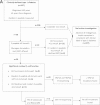Systematic assessment of etiology in adults with a clinical diagnosis of young-onset type 2 diabetes is a successful strategy for identifying maturity-onset diabetes of the young
- PMID: 22432108
- PMCID: PMC3357216
- DOI: 10.2337/dc11-1243
Systematic assessment of etiology in adults with a clinical diagnosis of young-onset type 2 diabetes is a successful strategy for identifying maturity-onset diabetes of the young
Abstract
Objective: Misdiagnosis of maturity-onset diabetes of the young (MODY) remains widespread, despite the benefits of optimized management. This cross-sectional study examined diagnostic misclassification of MODY in subjects with clinically labeled young adult-onset type 1 and type 2 diabetes by extending genetic testing beyond current guidelines.
Research design and methods: Individuals were selected for diagnostic sequencing if they displayed features atypical for their diagnostic label. From 247 case subjects with clinically labeled type 1 diabetes, we sequenced hepatocyte nuclear factor 1 α (HNF1A) and hepatocyte nuclear factor 4 α (HNF4A) in 20 with residual β-cell function ≥ 3 years from diagnosis (random or glucagon-stimulated C-peptide ≥ 0.2 nmol/L). From 322 with clinically labeled type 2 diabetes, we sequenced HNF1A and HNF4A in 80 with diabetes diagnosed ≤ 30 years and/or diabetes diagnosed ≤ 45 years without metabolic syndrome. We also sequenced the glucokinase (GCK) in 40 subjects with mild fasting hyperglycemia.
Results: In the type 1 diabetic group, two HNF1A mutations were found (0.8% prevalence). In type 2 diabetic subjects, 10 HNF1A, two HNF4A, and one GCK mutation were identified (4.0%). Only 47% of MODY case subjects identified met current guidelines for diagnostic sequencing. Follow-up revealed a further 12 mutation carriers among relatives. Twenty-seven percent of newly identified MODY subjects changed treatment, all with improved glycemic control (HbA(1c) 8.8 vs. 7.3% at 3 months; P = 0.02).
Conclusions: The systematic use of widened diagnostic testing criteria doubled the numbers of MODY case subjects identified compared with current clinical practice. The yield was greatest in young adult-onset type 2 diabetes. We recommend that all patients diagnosed before age 30 and with presence of C-peptide at 3 years' duration are considered for molecular diagnostic analysis.
Figures


Comment in
-
Diabetes: Extended genetic testing improves MODY diagnosis.Nat Rev Endocrinol. 2012 Apr 10;8(6):319. doi: 10.1038/nrendo.2012.56. Nat Rev Endocrinol. 2012. PMID: 22488647 No abstract available.
References
-
- Molven A, Njølstad PR. Role of molecular genetics in transforming diagnosis of diabetes mellitus. Expert Rev Mol Diagn 2011;11:313–320 - PubMed
-
- Steele AM, Wensley KJ, Shields BM, Shepherd M, Ellard S, Colclough K, Hattersley AT. Microvascular complication risk in patients with 50 years of moderate hyperglycaemia: are target ranges for glycaemic control appropriate [Abstract]? Diabet Med 2011;28(Suppl. 1):28
Publication types
MeSH terms
Substances
Grants and funding
LinkOut - more resources
Full Text Sources
Medical
Miscellaneous

